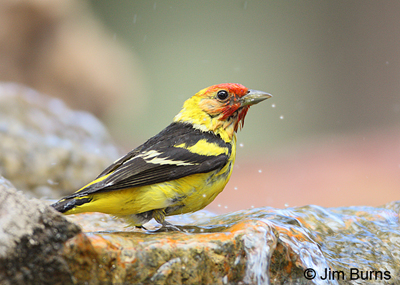
The facts of avian migration were known and understood long before the triggers behind that migration. It is now scientific consensus that there are several reasons for bird migration but the primary one, the main trigger, is length of day. As the days get shorter, birds’ food supplies in the more northerly latitudes dwindle. Birds must follow a food route, and their southward migration is seasonal, predictable, and repeatable just as were the migratory movements of the earliest humans and, of course much later, the Valley’s “snowbirds,” though I doubt we’ll see any of the latter drinking at our fountain.
Though both Bullock’s and Hooded Orioles breed in the foothills of the Valley, we have never had residents in our neighborhood nor seen them during nesting season. The grosbeaks and tanagers we see in spring and fall are headed farther for even higher country, but all these passages mark the seasons much more precisely than any temperature or weather that might accompany them.
Here are our early and late fall dates for the four species:
Bullock’s Oriole—8/17>>>9/16
Hooded Oriole—7/25>>>9/7
Black-headed Grosbeak—8/10>>>10/26
Western Tanager—8/11>>>9/28
The only immediately discernable pattern is that during this time frame it was usually hotter than hell, but the birds were already on the move. Sure, some individuals in every species are earlyish and latish, but genetic predisposition or local weather events far from the Valley may trigger these migratory outliers. It is not uncommon to hear stories of migrants appearing at a specific site on exactly the same date several years in a row and, indeed, we have had a male Black-headed Grosbeak at our fountain the past four Augusts on 8/22, 8/23, 8/24, and 8/26 respectively. It would not surprise me to discover this was the exact same bird all four years.
Length of day is, for the birds, their alarm clock. You set your alarm for the same time every workday morning or you’ll lose your job, and hence your income and your food supply. Birds have the exact same survival protocol. They have to be on time, no matter what the temperatures or weather, just as you do. The only difference is they’re not whining about things out of their control. They’re just dealing with it.